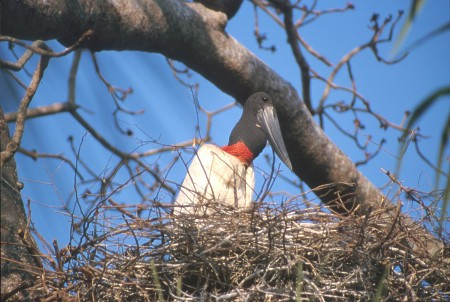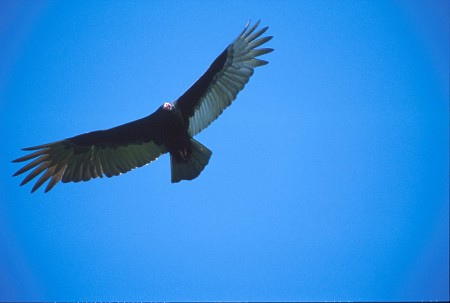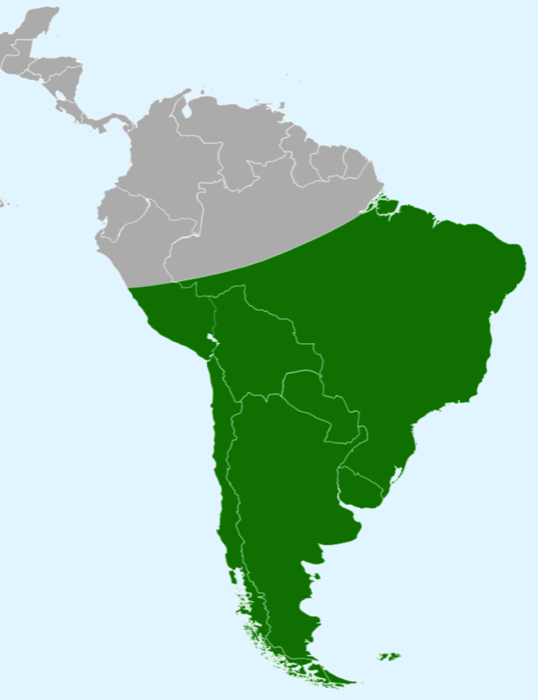Southern-crested Caracara
The Southern Crested Caracara is a common sight throughout the Pantanal - particularly in open grasslands and along riverbanks. It's a species of large falcon, second biggest in the world by mean body mass - with a length of 50–65 cm and a wingspan of 120–130 cm.
Although caracara are a species of falcons, they lack the fast-flying aerial hunting ability of their smaller cousins. Caracaras are opportunists that will take whatever is readily (and easily) available - eating a wide variety of small animals such as small mammals, lizards, snakes, juvenile birds and invertebrates. They're also happy to steal food from other birds and scavenge - and can sometimes be seen chasing vultures from animal carcasses. They'll also attack vultures in flight - forcing them to drop or regurgitate their food.
Feeding opportunities are more plentiful in the dry season, when grassland fires flush out large numbers of smaller animals, leaving behind carrion. This is also the season when large numbers of fish are left stranded in drying pools. Other related caracara species in the Pantanal include the Black Caracara, Red-throated Caracara, and Yellow-headed Caracara.
The Southern Crested Caracara ranges across almost all of South America south of the Amazon. Another very closely related species, the Northern Crested Caracara occurs north of the Amazon and ranges up through Central America to Texas and Florida. Both species are very similar - although the southern species is slightly bigger and has minor differences in colour (being slightly lighter and exhibiting greater barring or mottling). Although the species is widespread, individual birds are often sedentary - moving only locally within their environment.
The species prefers open country at low to mid-level elevations and is therefore less likely to be found in urban settings or mountainous regions. Areas such as the Pantanal, which offer open space and relatively low levels of development, provide a perfect habitat - with plenty of easily available prey and carrion. As an opportunist, Caracara can often be seen competing with black vultures, and near roadsides feeding on roadkill.
Caracaras are typically solitary or live in pairs, although multiple groups may gather together at larger food sources. Caracaras are most active between sunrise and about 1100 hours and again between about 1600 hours and sunset. They'll generally rest and sit out the hottest hours in the middle of the day.
In the cooler (more southern) parts of its range, breeding typically takes place in spring/summer - but this timing is less strict in regions such as the Pantanal. During breeding periods, bare skin on the face of the caracara can turn yellow - particularly during courtship and aerial displays. Prospective mates can sometimes be seen soaring through the air together - although there may also be aerial fights between competing males.
Feeding opportunities are more plentiful in the dry season, when grassland fires flush out large numbers of smaller animals, leaving behind carrion. This is also the season when large numbers of fish are left stranded in drying pools. Other related caracara species in the Pantanal include the Black Caracara, Red-throated Caracara, and Yellow-headed Caracara.
Behaviour and Habitat
The Southern Crested Caracara ranges across almost all of South America south of the Amazon. Another very closely related species, the Northern Crested Caracara occurs north of the Amazon and ranges up through Central America to Texas and Florida. Both species are very similar - although the southern species is slightly bigger and has minor differences in colour (being slightly lighter and exhibiting greater barring or mottling). Although the species is widespread, individual birds are often sedentary - moving only locally within their environment.
The species prefers open country at low to mid-level elevations and is therefore less likely to be found in urban settings or mountainous regions. Areas such as the Pantanal, which offer open space and relatively low levels of development, provide a perfect habitat - with plenty of easily available prey and carrion. As an opportunist, Caracara can often be seen competing with black vultures, and near roadsides feeding on roadkill.
Caracaras are typically solitary or live in pairs, although multiple groups may gather together at larger food sources. Caracaras are most active between sunrise and about 1100 hours and again between about 1600 hours and sunset. They'll generally rest and sit out the hottest hours in the middle of the day.
Reproduction
In the cooler (more southern) parts of its range, breeding typically takes place in spring/summer - but this timing is less strict in regions such as the Pantanal. During breeding periods, bare skin on the face of the caracara can turn yellow - particularly during courtship and aerial displays. Prospective mates can sometimes be seen soaring through the air together - although there may also be aerial fights between competing males.
Southern Crested Caracara in flight. Credit: Charles Sharp/Wikimedia
Scientific Name
Caracara plancus

Local Name
Caracara

Description
Large falcon, with a length of 50–65 cm and a wingspan of 120–130 cm.
Dark brown with a much lighter mottled chest and head. The head is topped with a black crown and a slightly bushy crest.
This species is common and conspicuous within it's range where it can often be seen perching near open spaces and foraging on foot like a chicken.
Once matched, the pair will build a large round open nest made of sticks, and sometimes lined with dry grass, dung or wool. Nests are typically located at the top of a tree or palm, with pairs favouring re-use of the same nesting locations year after year - although they might also move between a small number of alternate sites. Once the nest is ready, the female lays a clutch of two eggs which she and the male take turns to incubate. The adult not incubating will often perch high and visibly in a tall tree within 300m of the nest, serving as a lookout. The incubation period is around 30 days. At hatching, chicks have fluffy pinkish-brown down feathers, with a darker brown crown and back. The chicks will fledge - growing bigger, stronger and developing their flight feathers - making their first flight at around three months. Crested caracaras are devoted parents - making guttural clucking noises and snapping branches with their beaks to deter predators away from the nest.
Quick Facts
- The name Caracara comes from the indigenous Tupi name karaka'rá.
- As the dry season approaches in the Pantanal, when ponds start drying up, with the fish dying from lack of oxygen - caracaras are usually first on the scene to enjoy an easy meal.
- It's been suggested that the closely related Northern Crested Caracara was might have been the sacred "eagle" depicted in pre-Columbian Aztec codices (rather than the commonly accepted Golden Eagle whose range occupies only a very tiny portion of Mexico).
- Crested caracara can survive around 18 years in the wild, and more than 30 years in the captivity.
Conservation Threats
Since they thrive in open area, deforestation and land development can be beneficial for crested caracara - so long as their nesting locations remain relatively undisturbed. Global numbers appear to be increasing as grasslands are expanded for agriculture. As such, their Conservation Status is Least Concern - meaning that there are no imminent threats noted for their survival.








Banner image: Southern Crested Caracara (Shutterstock/Natalia Sinjushina & Evgeniy Meyke)
Footer images: Tuiuiú, Turkey Vulture(Andrew Mercer); Amazon Kingfisher (Shutterstock/Ecoventurestravel)


Pantanal Escapes